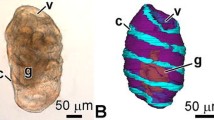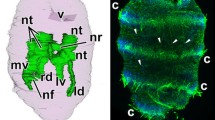Abstract
Larval protonephridia appear as paired ectodermal invaginations on the posterior body end of the larva (actinotrocha), at early stages of its development. The protonephridium of the early actinotrocha has a straight canal and one group of solenocytes distally. The protonephridium of the late actinotrocha has a U-shaped canal and two (upper and lower) groups of solenocytes. After metamorphosis, solenocytes degenerate and the canal is connected with metacoel. The metanephridial funnel is formed from the upper metacoelomic wall epithelium and the lateral mesentery. The definitive nephridium consists of two parts: the ectodermal canal (derived from the protonephridial canal) and the mesodermal funnel, a derivative of the coelomic epithelium. Thus, the phoronid excretory organ is a nephromixium. Consecutive stages of the evolution of nephridia in phoronids are discussed.
Similar content being viewed by others
References
T. Bartolomaeus, “Ultrastructure and Development of the Nephridia in Anaitides mucosa (Annelida, Polychaeta),” Zoomorphology 109, 15–32 (1989a).
T. Bartolomaeus, “Ultrastructure and Relationship between Protonephridia and Metanephridia in Phoronis muelleri (Phoronida),” Zoomorphology 109, 113–122 (1989b).
W. H. Caldwell, “Preliminary Note on the Structure, Development and Affinities of Phoronics,” Proc. R. Soc. London 34, 371–383 (1882).
C. C. Emig, “British and Other Phoronides,” in Synopsis of the British Fauna (1979), Vol. 13, pp. 1–57.
M. A. Goodrich, “On the Body-Cavities and Nephridia of the Actinotrocha Larva,” Quart. J. Microscop. Sci. 47, 103–121 (1903).
M. A. Goodrich, “Notes on the Nephridia of Dinophilus and of the Larvae of Polygordius, Echiurus, and Phoronis,” Quart. J. Microscop. Sci. 54, 111–118 (1910).
E. S. Goodrich, “The Study of Nephridia and Genital Ducts since 1895,” Quart. J. Microscop. Sci. 86, 113–392 (1945).
A. Hay-Schmidt, “The Ultrastructure of the Protonephridium of the Actinotrocha Larva (Phoronida),” Acta Zool. 68, 35–47 (1987).
I. Ikeda, “Observation on the Development, Structure and Metamorphosis of Actinotrocha,” J. Coll. Sci., Imp. Univ. Tokyo 13, 507–591 (1901).
Yu. V. Mamkaev, “On Phoronids from Far Eastern Seas,” Issled. Dal’nevost. Morei SSSR 8, 219–237 (1962).
K. R. Menon, “Notes of Actinotrocha,” Quart. J. Microscop. Sci. 45, 473–484 (1902).
J. Müller, “Bericht über einige Tierformen der Nordsee,” Arch. Anat. Physiol. 13, 101–104 (1846) (Cited from L.H. Hyman, The Invertebrates, Vol. 5: Smaller Coelomate Groups (McGraw-Hill, New York, 1959)).
M. Selys-Longchamps, “Developpement des Phoronis,” Arch. Biol. 18, 495–597 (1902).
M. Selys-Longchamps, “Developpement post-embrionnaire et affinites des Phoronis,” Mem. Sci. Acad. R. Belg. 1, 1–150 (1904).
C. Shearer, “Studies on the Development of Larval Nephridia: 1. Phoronis,” Mit. Zool. St. Neapel 17, 487–514 (1906).
P. R. Smith and E. E. Ruppert, “Nephridia,” in The Ultrastructure of Polychaeta. Microfauna Marina, Ed. by W. Westheide and C.O. Hermans (1988), pp. 231–262.
E. N. Temereva and V. V. Malakhov, “The Morphology of the Phoronid Phoronopsis harmeri,” Biol. Morya 27(1), 34–42 (2001) [Russ. J. Mar. Biol. 27 (1), 21–30 (2001)].
E. N. Temereva and V. V. Malakhov, “Specific Features of Microscopic Anatomy and Ultrastructure of Metanephridia of the Phoronid Phoronopsis harmeri, Pixell, 1912 (Phoronida, Lophophorata),” Zool. Bespozv. 1(1), 93–103 (2004a).
E. N. Temereva and V. V. Malakhov, “Ul’trastructure of the Circulatory System of the Phoronid Phoronopsis harmeri Pixell, 1912: 1. Capillaries,” Biol. Morya 30(1), 46–53 (2004b) [Russ. J. Mar. Biol. 30 (1), 28–36 (2004)].
E. N. Temereva and V. V. Malakhov, “Ultrastructure of the Circulatory System of the Phoronid Phoronopsis harmeri Pixell, 1912: 2. Major Vessels,” Biol. Morya 30(2), 120–130 (2004c) [Russ. J. Mar. Biol. 30 (2), 101–112 (2004)].
R. Wagner, “Über den Bau der Actinotrocha branchiata,” Arch. Anat., Physiol., 202 (1847).
R. L. Zimmer, Reproductive Biology and Development of Phoronida (University of Washington, Ph.D. Zoology, Washington, DC, 1964).
Author information
Authors and Affiliations
Additional information
Original Russian Text © E.N. Temereva, V.V. Malakhov, 2006, published in Zoologicheskii Zhurnal, 2006, Vol. 85, no. 8.
Rights and permissions
About this article
Cite this article
Temereva, E.N., Malakhov, V.V. Development of excretory organs in Phoronopsis harmeri (Phoronida): From protonephridium to nephromixium. Entmol. Rev. 86 (Suppl 2), S201–S209 (2006). https://doi.org/10.1134/S0013873806110145
Received:
Issue Date:
DOI: https://doi.org/10.1134/S0013873806110145




